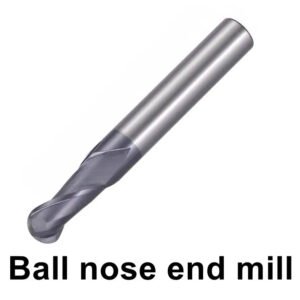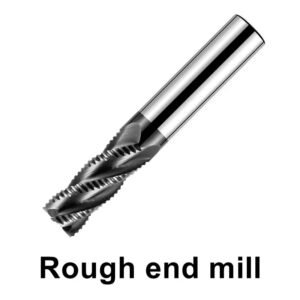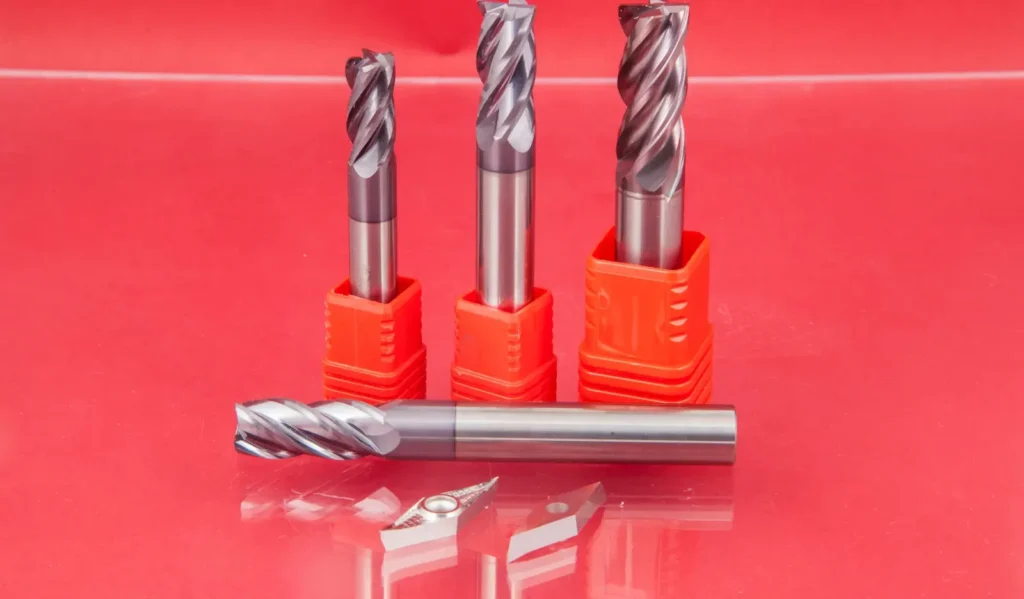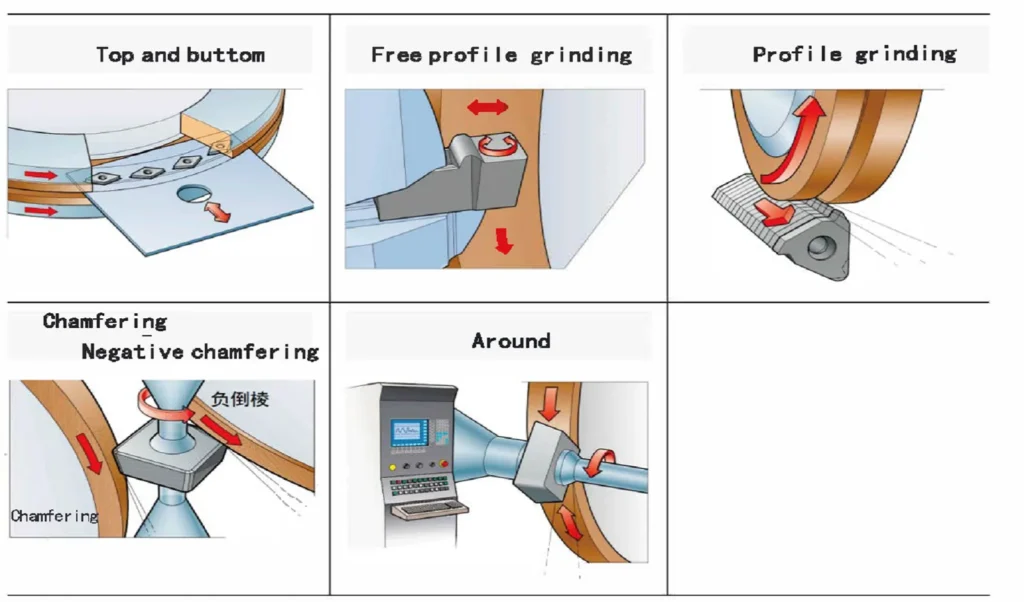가공 분야에서는 최적의 결과를 얻기 위해 작업에 적합한 공구를 선택하는 것이 중요합니다. 엔드 밀 는 밀링 작업에 사용되는 다용도 절삭 공구이며, 기계 가공자가 직면하는 가장 중요한 결정 중 하나는 다양한 플루트 구성 중에서 선택하는 것입니다. 이 글에서는 2플루트 엔드밀과 4플루트를 비교하여 각각의 특성, 응용 분야 및 성능에 영향을 미치는 요인을 살펴봅니다.

엔드밀 플루트의 이해
2플루트 엔드밀과 4플루트 엔드밀의 차이점을 자세히 알아보기 전에 플루트가 무엇이며 절삭 성능에 어떤 영향을 미치는지 이해하는 것이 중요합니다. 플루트는 엔드밀의 길이를 따라 이어지는 깊은 나선형 홈입니다. 이 홈은 절삭 날을 생성하고 밀링 공정 중에 칩 배출을 위한 채널을 제공하는 두 가지 주요 용도로 사용됩니다.
플루트의 개수 엔드 밀 는 다양한 애플리케이션에서 성능에 큰 영향을 미칠 수 있습니다. 일반적으로 엔드밀에는 2개에서 8개까지 플루트가 있으며, 2개 플루트 및 4개 플루트 구성이 가장 일반적입니다.
플루트 엔드 밀 2개
특성
두 개의 플루트 엔드밀은 넓은 플루트 공간과 날카로운 절삭날이 특징입니다. 이 설계 덕분에 칩 배출이 효율적이고 절삭력이 감소합니다.

장점
- 뛰어난 칩 클리어런스
- 낮은 절삭력
- 부드러운 소재에 이상적
- 플 런지 커팅에 더 적합
단점
- 일부 애플리케이션에서 안정성이 떨어짐
- 특정 소재의 경우 마감 처리가 거칠어질 수 있습니다.
2개의 플루트 엔드 밀은 어떤 용도로 사용되나요?
플루트 엔드 밀은 주로 두 가지 용도로 사용됩니다:
- 알루미늄, 황동, 플라스틱과 같은 부드러운 소재 절단
- 깊은 슬롯 또는 포켓이 필요한 밀링 애플리케이션
- 칩 배출이 중요한 운영 환경
- 플 런지 절단 및 드릴링 작업
플루트 엔드 밀 4개
특성
네 개의 플루트 엔드 밀 는 2개의 플루트에 비해 더 많은 절삭날과 더 작은 플루트 공간을 가지고 있습니다. 이 구성은 많은 애플리케이션에서 안정성이 향상되고 표면 마감이 개선됩니다.

장점:
- 커팅 시 안정성 향상
- 향상된 표면 마감
- 더 높은 피드 속도 가능
- 더 단단한 소재에 적합
단점:
- 칩 간극 감소
- 더 높은 절삭력
- 플 런지 커팅의 효율성이 떨어짐
4개의 플루트 엔드 밀은 어떤 용도로 사용되나요?
일반적으로 4개의 플루트 엔드 밀이 사용됩니다:
- 강철 및 스테인리스 스틸과 같은 단단한 재료 절단
- 표면 품질이 중요한 마감 작업
- 측면 밀링 및 프로파일링 작업
- 더 빠른 이송 속도가 필요한 애플리케이션
2 플루트 엔드 밀과 4 플루트 엔드 밀 비교
2플루트 엔드밀과 4플루트 엔드밀 사이의 선택은 몇 가지 요인에 따라 달라집니다. 주요 차이점을 살펴보겠습니다:
- 절삭 효율: 2플루트 엔드밀은 일반적으로 칩 부하가 크고 칩 배출이 개선되어 부드러운 소재에서 더 나은 절삭 효율을 제공합니다. 그러나 4플루트 엔드밀은 더 많은 모서리에 절삭력을 분산하기 때문에 더 단단한 재료에서 더 효율적일 수 있습니다.
- 재료 제거율: 많은 경우, 2플루트 엔드밀은 특히 부드러운 소재에서 더 높은 소재 제거율을 달성할 수 있습니다. 이는 더 깊은 절삭과 더 큰 칩 부하를 처리할 수 있기 때문입니다. 그러나 4플루트 엔드밀은 더 높은 이송 속도를 사용할 수 있기 때문에 더 단단한 소재에서 더 높은 제거율을 달성할 수 있는 경우도 있습니다.
- 표면 마감: 일반적으로 4개의 플루트 엔드 밀은 2개의 플루트 엔드 밀에 비해 더 나은 표면 마감을 제공합니다. 추가 절삭 날은 작업을 더 고르게 분배하여 더 매끄러운 표면을 만드는 데 도움이 됩니다. 따라서 정삭 작업에는 4개의 플루트 엔드 밀을 사용하는 것이 좋습니다.
- 열 방출: 2플루트 엔드밀은 일반적으로 플루트 공간이 넓기 때문에 열 방출 특성이 더 우수합니다. 이는 열에 민감한 재료로 작업하거나 냉각이 제한적인 환경에서 작업할 때 특히 유용할 수 있습니다.
- 공구 수명: 엔드밀의 공구 수명은 절삭되는 재료와 절삭 매개변수 등 다양한 요인에 따라 달라집니다. 일반적으로 4플루트 엔드밀은 더 많은 절삭날에 마모가 분산되기 때문에 단단한 재료를 절단할 때 공구 수명이 더 길 수 있습니다. 그러나 2플루트 엔드밀은 열 축적이 적고 절삭력이 낮기 때문에 부드러운 소재에서는 더 오래 사용할 수 있습니다.

전문 비교
보다 포괄적인 이해를 돕기 위해 다른 플루트 구성을 간략하게 비교해 보겠습니다:
- 2플루트 엔드밀 대 3플루트 엔드밀: 3플루트 엔드밀은 2플루트 엔드밀의 칩 배출과 4플루트 엔드밀의 안정성 사이에서 균형을 제공합니다. 알루미늄과 같은 소재에 주로 사용되며, 2플루트 밀에 비해 우수한 칩 제거율을 유지하면서 향상된 마감 품질을 제공할 수 있습니다.
- 2플루트 엔드밀과 3플루트 엔드밀 알루미늄: 알루미늄 가공 시 2플루트 엔드밀과 3플루트 엔드밀 모두 효과적일 수 있습니다. 2플루트 엔드밀은 칩 배출에 탁월하며 딥 포켓 가공에 이상적입니다. 3플루트 엔드밀은 칩 제거와 표면 정삭 사이의 균형을 제공하여 다양한 알루미늄 가공 작업에 적합합니다.
- 2플루트 엔드밀과 3플루트 엔드밀 목재: 목재 가공의 경우 일반적으로 칩 배출 특성이 뛰어난 2플루트 엔드밀이 선호됩니다. 그러나 3플루트 엔드밀은 일부 목재 유형에서 더 매끄러운 마감을 제공할 수 있으며 엔지니어링 목재 제품으로 작업할 때 유용할 수 있습니다.
- 2 플루트 대 4 플루트 볼 노즈 엔드밀: 볼 노즈 엔드밀은 3D 컨투어링 및 정삭 작업에 사용됩니다. 2플루트 볼 노즈 엔드밀은 더 부드러운 소재와 칩 배출이 중요한 경우에 더 적합합니다. 4플루트 볼 노즈 엔드밀은 향상된 표면 조도를 제공하며 더 단단한 재료 및 정삭 작업에 선호됩니다.
- 3플루트 엔드밀과 4플루트 엔드밀: 3플루트 엔드밀과 4플루트 엔드밀 중 선택은 종종 특정 재료와 용도에 따라 결정됩니다. 3플루트 엔드밀은 칩 배출과 안정성의 균형이 잘 잡혀 있어 다양한 소재에 다용도로 사용할 수 있습니다. 4플루트 엔드밀은 안정성과 표면 조도를 극대화하여 더 단단한 소재와 정삭 작업에 이상적입니다.
올바른 엔드밀 선택하기
2플루트 엔드밀과 4플루트 엔드밀 중에서 선택할 때는 다음 요소를 고려하세요:
- 재료: 부드러운 소재는 일반적으로 2개의 플루트 엔드 밀을 사용하는 것이 좋으며, 단단한 소재는 4개의 플루트 엔드 밀이 필요할 수 있습니다.
- 작업 유형: 황삭 작업은 보통 2개의 플루트 엔드밀을 선호하는 반면, 정삭 작업은 일반적으로 4개의 플루트 엔드밀이 유리합니다.
- 칩 배출: 칩 제거가 주요 관심사인 경우 일반적으로 2개의 플루트 엔드 밀이 더 나은 선택입니다.
- 표면 마감: 특히 더 단단한 소재에서 우수한 표면 마감을 위해 4 플루트 엔드 밀이 선호되는 경우가 많습니다.
- 안정성: 공구 휨이 우려되는 응용 분야에서는 4개의 플루트 엔드밀이 더 나은 안정성을 제공합니다.
- 이송 속도: 더 빠른 이송 속도가 필요한 경우, 특히 더 단단한 재료에서는 4플루트 엔드밀이 더 적합할 수 있습니다.
자료별 권장 사항
- 알루미늄: 2 플루트 또는 3 플루트 엔드 밀 는 칩 배출 특성 때문에 선호되는 경우가 많습니다.
- 스틸: 일반적으로 안정성과 표면 마감 기능을 위해 4개의 플루트 엔드 밀이 사용됩니다.
- 목재: 일반적으로 칩 제거 능력을 위해 2개의 플루트 엔드 밀을 권장합니다.
- 플라스틱: 일반적으로 녹는 것을 방지하고 칩을 적절히 배출하기 위해 2개의 플루트 엔드 밀이 선호됩니다.
결론
2플루트 엔드밀과 4플루트 엔드밀의 차이점을 이해하는 것은 가공 작업을 최적화하는 데 매우 중요합니다. 2플루트 엔드밀은 칩 배출 및 부드러운 소재 절삭에 탁월한 반면, 4플루트 엔드밀은 특히 단단한 소재에서 향상된 안정성과 표면 조도를 제공합니다.
이 두 가지 구성 중 선택은 가공되는 소재, 작업 유형, 원하는 표면 정삭, 칩 배출 요구 사항 등 다양한 요인에 따라 달라집니다. 이러한 요소를 신중하게 고려하고 각 구성의 장단점을 이해함으로써 기계 가공자는 특정 응용 분야에 가장 적합한 엔드밀을 선택하여 궁극적으로 생산성 향상, 부품 품질 개선 및 공구 수명 연장으로 이어질 수 있습니다.
가공에는 만능 솔루션이 없다는 사실을 기억하세요. 실험과 경험을 통해 엔드밀 선택 프로세스를 미세 조정하여 밀링 작업에서 최상의 결과를 얻을 수 있습니다. 알루미늄, 강철, 목재, 플라스틱 등 어떤 소재를 가공하든 올바른 엔드밀 구성을 선택하는 것은 성공적인 가공을 위한 중요한 단계입니다.


